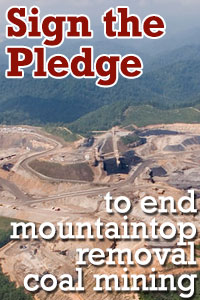Communities, Welcome to the Community of Mud River, West Virginia
“We are still in America, aren’t we?” – Bill Hoffman, leader of EPA’s enviromental study on the impact of mountaintop removal
Friday, October 19th, 2007
Mud River hasn’t been much of a community for more than two decades. The Post Office and the school have been gone for a long time. But for the past 30 or so years it had been home to about 60 families.
The residents had two churches and a ball field. The flat land along the river was dark and fertile. Corn and vegetables grew well on the few acres. Some families had a few horses and cattle pastured on the flat land.
No longer. Where there were once some 60 families, only five remained at the beginning of 1998 after Arch Coal Inc.’s Hobet 21 Mine was expanded across the Boone County line into Lincoln County. West Virginia’s [then] longest valley fill was approved at Connelly Branch, less than half a mile from the start of Mud River. The fill comes two miles from the mine to the river.
When Therman and Lorene Caudill moved to their present home in Mud River in 1966, they planned to stay the rest of their lives. In the early years there was a moratorium on strip mining in Lincoln County. So they had few concerns about mines. With little notice, the moratorium expired when the Surface Mine Control and Reclamation Act was passed in 1977.
Since the Hobet 21 Mine moved in, blasting has been a continual problem. Therman Caudill’s brother complained a lot to the Department of Environmental Protection. The director of DEP actually issued orders to reduce the blasting. It didn’t seem to help much. Finally, the land company associated with the mine bought him out-under one condition: He could not move back into the Mud River watershed, ever. Seemed the mine didn’t want him complaining anymore. Bill Hoffman, who is one of the leaders of the US Environmental Protection Agency’s environmental impact study of mountaintop removal, was shocked at the restriction. “We are still in America, aren’t we?” he said.
Original text contributed by distinguished author Penny Loeb from her website www.wvcoalfield.com Photo by Vivian Stockman and provided courtesy of the Ohio Valley Environmental Coalition and Southwings.










September 24th, 2010 at 2:08 pm
my mothers family my [grandparents] were born and raised on mud river they were the spears family i loved to go visit them it was much better than where we lived buffalo creek lorado,crites,amherstdale most of these places are gone now replaced by little bunches of house trailers.I could hardly recognise my birth place when i was there a couple years back,i left sad and downhearted to see what the co.had done to our creeks, branches and beautiful mountain home.